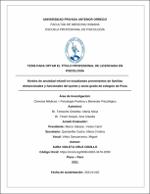Niveles de ansiedad infantil en estudiantes provenientes de familias disfuncionales y funcionales del quinto y sexto grado de colegios de Piura

View/
Download
(application/pdf: 1.500Mb)
(application/pdf: 1.500Mb)
Date
2022Author(s)
Temoche Ordoñez, María Alicia
Tesen Duque, Ana Claudia
Metadata
Show full item recordAbstract
La presente tuvo como objetivo establecer la diferencia en los niveles de
ansiedad infantil entre los estudiantes provenientes de familias disfuncionales y
funcionales de quinto y sexto grado de primaria de colegios de Piura. La cual ha sido
realizada con un diseño descriptivo- comparativo, para medir y establecer el nivel de
ansiedad en niños provenientes de familias disfuncionales y funcionales de una institución
particular (I.E.P “Las Capullanas) y estatal (I.E “J.E.M.V). La población estuvo constituida
por 133 niños, varones y mujeres, entre las edades de 10 y 12 años del quinto y sexto
grado de dos instituciones educativas.
Cabe mencionar que fueron evaluados por CAS (cuestionario de Ansiedad
Infantil) el cual está comprendido por las manifestaciones que enmarcan la dimensión
Emocional- Excitabilidad y la dimensión Timidez- Dependencia.
Los resultados evidenciaron que los niños provenientes de familias
disfuncionales presentaron un mayor porcentaje del nivel de ansiedad en las dos
dimensiones que evalúa el instrumento.
Por lo tanto, se concluyó que se rechaza la hipótesis nula dado que si existen
diferencias significativas en el nivel de ansiedad infantil en los estudiantes de quinto y
sexto grado de primaria de dos instituciones pública – privada provenientes de familias
disfuncionales y funcionales. The objective of this was to establish the difference in the levels of childhood
anxiety among students from dysfunctional and functional families in fifth and sixth grade
of primary schools in Piura. Which has been carried out with a descriptive-comparative
design, to measure and establish the level of anxiety in children from dysfunctional and
functional families of a private institution (I.E.P ““Las Capullanas) and state (I.E ““J.E.M.V).
The population consisted of 133 children, men and women, between the ages of 10 and
12 years of the fifth and sixth grade of two educational institutions.
It is worth mentioning that they were evaluated by CAS (Childhood Anxiety
Questionnaire) which is comprised of the manifestations that frame the Emotional Excitability dimension and the Shyness-Dependence dimension.
The results showed that children from dysfunctional families presented a higher
percentage of the level of anxiety in the two dimensions evaluated by the instrument.
Therefore, it was concluded that the null hypothesis is rejected given that there
are significant differences in the level of childhood anxiety in fifth and sixth grade
students of two public-private institutions from dysfunctional and functional families.
Collections
- Psicología [531]

